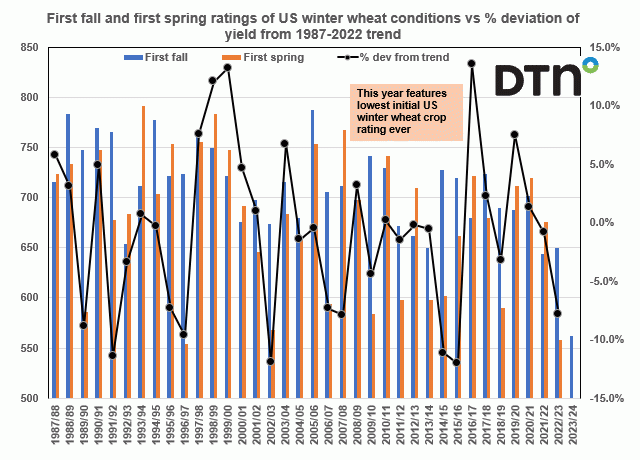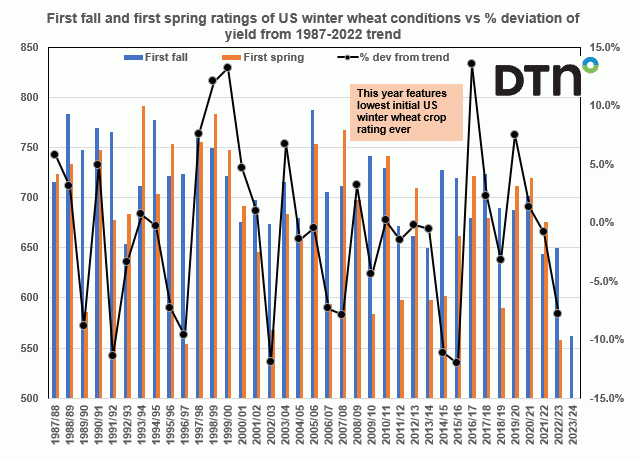Fundamentally Speaking
Lowest Initial Wheat Ratings Amid Drought
With U.S. and world wheat prices among the highest in years, reflective of low inventories, uncertainty about the longevity of the Ukraine grain export corridor deal and poor crops this season for U.S. winter wheat along with those in Argentina and India for the 2023/24 season, good production is needed both here and abroad to rebuild stocks which perhaps would lead to some relaxation in values.
Unfortunately, here in the U.S. the initial outlook for the 2023 U.S. winter wheat is just abysmal as despite some moisture over the past week, it is still very dry in the central and Southern Plains, the Delta and much of the southern Midwest to the detriment of the U.S. crop.
According to the U.S. Drought Monitor of Nov. 2, drought covers 74% of winter wheat acres which is unchanged from last week with extreme or exceptional drought now covering 59% of Kansas, including virtually all of the southern half of the state and many of the western counties.
In HRW areas, dryness/drought covers 83% of Colorado, 100% of Kansas, 90% of Montana, 100% of Nebraska, 100% of Oklahoma, 100% of South Dakota and 92% of Texas.
P[L1] D[0x0] M[300x250] OOP[F] ADUNIT[] T[]
In SRW areas, dryness/drought covers 93% of Missouri, 79% of Illinois, 98% of Indiana, 86% of Ohio, 40% of Michigan, 99% of Kentucky, and 98% of Tennessee.
No wonder then that first USDA winter wheat production report this week showed a mere 28% in either the good or excellent category, by far the worst initial crop rating ever since this data series started back in 1986.
Using our usual ratings system (where we weight the crop based on the percent in each category and assign that category a factor of 2 for very poor, 4 for poor, 6 for fair, 8 for good, and 10 for excellent and then sum the results) this chart shows the first USDA fall crop rating for the U.S. winter wheat crop.
Also plotted on the left-hand axis are the first spring conditions which are usually released the first week of April when the crop has come out of its winter dormancy.
On the right-hand axis is the percent that the final crop year yield estimates deviated from the 1987-2022 year trend of final yields.
The initial rating for the 2023 U.S. winter wheat crop at 562 is by far the lowest ever since the USDA started national crop ratings in 1986 as not only is the figure well below the 1986-2021 average of 708 but there is no other year even below 600.
The severe drought in the Plains is actually an accumulation of three years of drought as the two other lowest initial U.S. winter wheat ratings came last year at 650 and the year prior at 644 which is the second lowest.
We should note that a large part of the area that has already been planted saw the farmers literally dusting the crop in where seed is placed in dry soils with the hope that some precipitation comes and allows for germination as many producers opting for this rather risky planting strategy in order to take advantage of the highest new crop wheat prices ever for this time of year.
This leads to questions of emergence and hardiness of crop and how it will withstand the vicissitudes of winter weather as on average crop ratings usually decline by 39 points from the final fall to the first spring rating.
It is still early in the season so should the crop get some moisture over the next few months, have a low incidence of winterkill if any and good spring precipitation, there is a chance the U.S. winter wheat crop could pull a rabbit out of its hat and have respectable yields but right now the odds seem stacked against such an occurrence.
(c) Copyright 2022 DTN, LLC. All rights reserved.






Comments
To comment, please Log In or Join our Community .